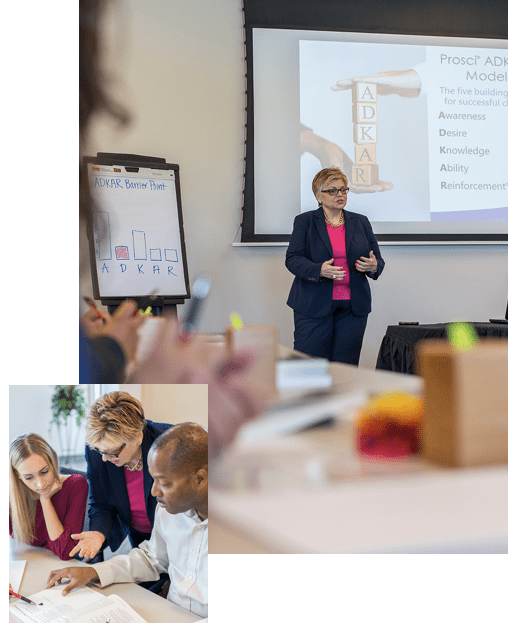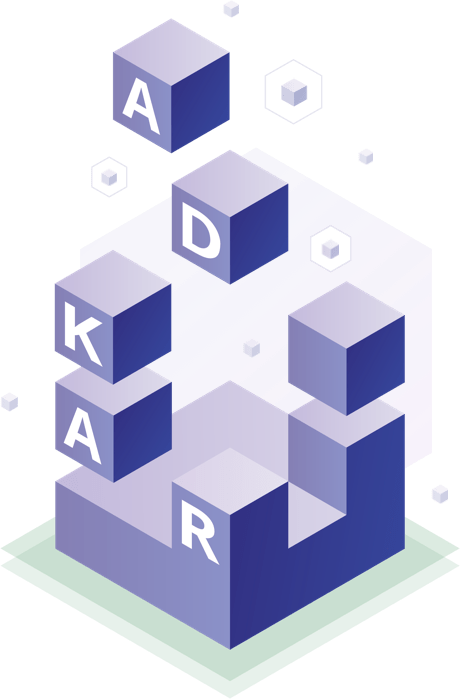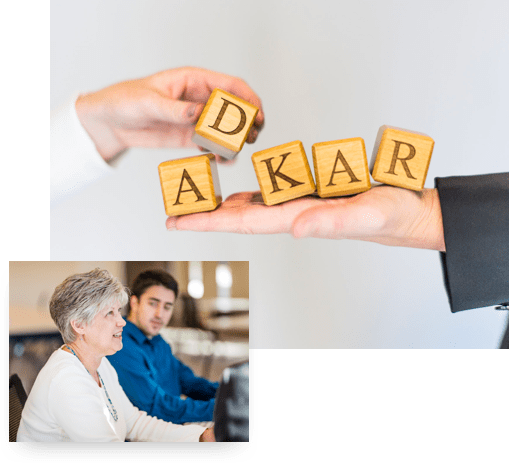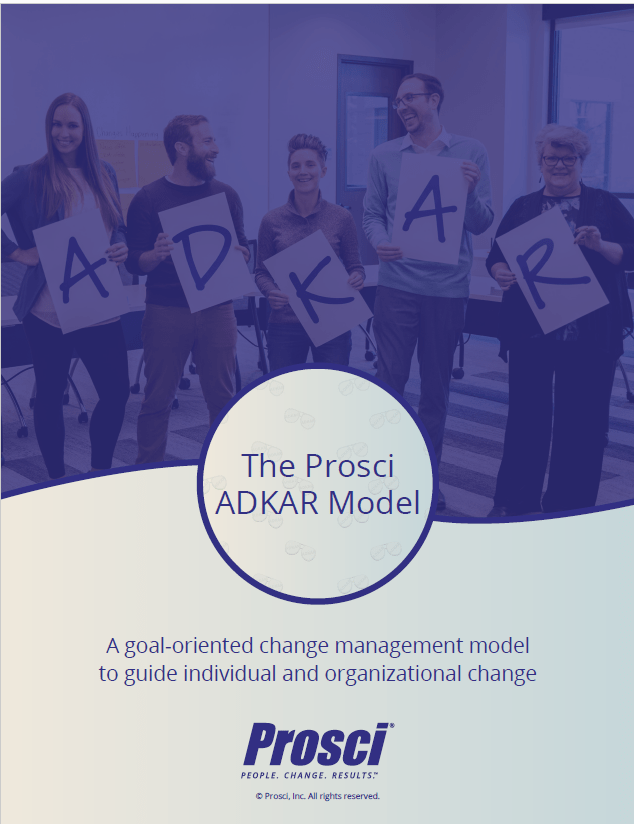The Prosci® ADKAR®Model
A simple but powerful model for driving successful change in individuals and organizations.
Focusing on the people side of change
The Prosci ADKAR® Model is one of the most widely requested and sought-after models for change management. Backed by 20 years of Prosci research, the model is based on the common—yet often overlooked—reality that organizational change only happens when individuals change.
The ADKAR Model drives powerful results by supporting individual changes to achieve organizational success. The model offers a structured approach to ensure that each individual experiencing change moves through the five phases necessary to make overall change successful.
Prosci’s ADKAR® Model is the best framework to prepare individuals to accept a significant change and thrive in a new way of doing business.
Leslie W. Lenser, Texas A&M University

What makes the Prosci ADKAR®Model so successful?
Prosci’s change management methodology and ADKAR Model are continually developed based on research since 1998 with over 4,500 participants. The methodology and model are unique. They come from real project leaders and teams reflecting on what worked, what didn’t work, and what they would do differently on their next project or change initiative.
At its core, Prosci’s methodology is the collective lessons learned across the globe by those implementing change.
The ADKAR® process is effective and powerful. The systematic progression toward change enables proper buy-in and readiness. It has helped our company and clients. PROSCI is a choice business partner.
Shannon Cassidy, Bridge Between, Inc.
Why do I need to apply the ADKAR® Model to my change initiatives?
When organizational change initiatives fail, it isn’t necessarily because the change solution is ineffective. Most failure happens on the people side:
- Employees don’t understand the benefits of adopting new technologies and tools
- Employees aren’t prepared to be successful in the new environment
- Leaders aren’t equipped to sponsor change and manage resistance effectively
The ADKAR Model paves the way for successful change by equipping people with a common language for change. It enables leaders to plan and guide change activities, and it helps individuals within your organization see themselves as part of the solution.
Working our Adoption and Change Management program through the ADKAR Model gave us a higher degree of engagement. We were treating people differently.
Jean-Claude Monney, Microsoft

What is the ADKAR® Model?
The Prosci ADKAR® Model is a goal-oriented change management model that guides individual and organizational change. Created by Prosci founder Jeff Hiatt, ADKAR is an acronym that represents the five tangible and concrete outcomes that people need to achieve for lasting change: awareness, desire, knowledge, ability and reinforcement.
By outlining the goals and outcomes of successful change, the ADKAR Model is an effective tool for planning change management activities, equipping your leaders facilitating change, and supporting your employees throughout the change.
A MODEL BASED ON CHANGE MANAGEMENT BEST PRACTICES
Organizational change begins with managing individual change
Change is often a complex and difficult process—and it’s inevitable. The most commonly cited reason for project failure is problems with the people side of change. Yet organizations often invest more in the technical side of change than in leading impacted people through times of change.
The first step in managing any type of organizational change is understanding how to manage the change that a single individual is experiencing. Driving successful change in individuals and organizations requires new thinking, new models for change, and new tools.
The Prosci ADKAR Model is proven to help organizations achieve the greatest benefits from their change initiatives.


Applying ADKAR®
Since the Prosci ADKAR Model was developed two decades ago, thousands of change leaders have applied it to their change initiatives to improve project outcomes.
The ADKAR Model distills the change process into the most basic yet critical elements, making it easy to use. Yet it’s a multipurpose, multifaceted tool that has the power to impact how you lead change and how individuals experience change in your organization.
Understanding change as a process
Fundamental to the ADKAR Model is this: Change occurs as a process, not an event. And it can be difficult and complex to understand. Breaking down change into distinct elements helps us understand the process of change and how to manage it. The theory of three distinct phases of change has roots in works from anthropologist Arnold Van Gennep in 1909 to Kurt Lewin in 1948 and William Bridges in 1980.
The three states of change – current state, transition state, and future state – provide a powerful framework for the process-oriented approach of the ADKAR Model. The model clearly establishes how an individual moves through the change process, from their current state to their future state, and provides the insight needed for successful organizational change.
CURRENT
To move out of the current state, an individual needs awareness of the need for change and a desire to participate in and support the change.
TRANSITION
Successfully moving through the transition state requires knowledge on how to change and the ability to implement the required skills and behaviors.
FUTURE
In the future state, individuals need ability and reinforcement to sustain the change.
A MODEL BASED ON CHANGE MANAGEMENT BEST PRACTICES
Driving change with the ADKAR® Model
In today’s organizations, change is constant. Whether the change is about processes, technologies, the structure of the organization, or something else, each change impacts how individual employees do their jobs. The success of the change depends on the success of change management in encouraging individuals to embrace, adopt and utilize a required change.
The ADKAR Model supports individuals through change. Success also requires integrating individual change management and organizational change management. The Prosci 3-Phase Process, another component of the Prosci change management methodology, provides a strategic, step-by-step approach to organizational change management.


Individual change management
Organizations don’t change, individuals do. No matter how large a project you are taking on, the success of that project ultimately lies with each employee doing their job differently, multiplied across all employees impacted by the change.
Individual change management means understanding how one person successfully makes a change. The ADKAR Model drives successful change at the individual level based on an appreciation of how change impacts each employee and how to support them through change.
Organizational change management
While change happens one person at a time, processes and tools can help facilitate this change across groups and organizations. Without a structured approach, change management tools are often limited to only communication and training.
Organizational change management leverages tools and methodologies that help individuals successfully make changes that contribute to reaching organizational goals. With an organizational change management perspective, a process emerges for how to scale change management activities and how to use the complete set of tools available for project leaders and business managers.


Connecting individual and organizational change management
The link between individual change management and organizational change management is what sets Prosci’s change management approach apart from other methodologies. Numerous models address individual change. And numerous models give guidance and structure to the project-level activities for the people side of change.
The Prosci methodology uniquely integrates individual change management and organizational change management to ensure that business results are achieved. This is the essence of effective change management and the Prosci methodology: leverage change management strategies and activities to drive individual transitions and ultimately organizational success.
The 3-Phase Process: A Structure for Organizational Change
Prosci’s organizational change management process is built in three phases that a project or change manager can work through for the changes and initiatives they are supporting. The methodology includes research-based assessments and templates to support each phase, as well as guidance for completing each step most effectively.
Phase 1 – Preparing for change
The first phase of the Prosci 3-Phase Process helps change and project teams prepare for designing their change management plans. It answers questions like:
- “How much change management does this project need?”
- “Who is impacted by this initiative and in what ways?”
The first phase provides the situational awareness that is critical for creating effective change management plans.
MECHANISIMS FOR PREPARING FOR CHANGE
Phase 2 – Managing change
The second phase of the Prosci 3-Phase Process focuses on creating plans that will integrate with the project plan. These change management plans articulate the steps that you can take to support the individuals impacted by the project. Based on Prosci’s research, there are five plans needed to effectively support individuals moving through the ADKAR Model.
MECHANISIMS FOR PREPARING FOR CHANGE
Phase 3 – Reinforcing change
Equally critical but most often overlooked, the third phase of the Prosci 3-Phase Process helps you create specific action plans for ensuring that the change is sustained. In this phase, project and change teams develop mechanisms to measure how well the change is taking hold, see if employees are actually doing their jobs the new way, identify and correct gaps, and celebrate success.
KEY STRATEGIES FOR REINFORCING CHANGE
Succeed with 6 Free ADKAR® Model Resources
Addressing the challenges of change is much simpler with a structured framework. Learn how to successfully apply all elements of the ADKAR Model.
